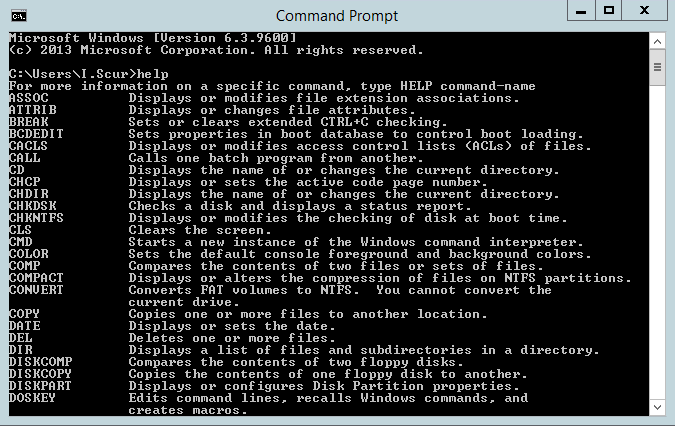
#LIST OF MS DOS COMMANDS WINDOWS 10 KEYGEN#

/cmd-commands-windows-57e599e75f9b586c35f1e965.png)
This command should send the contents of some file to the printer device (prn): c:\> copy somefile.txt prn Convert the output of one process into the input of another process or even pipe nothing into nowhere (yes!): c:\> copy somefile.txt nul > nul Print a file through DOSĪlthough I have as of yet been able to get this method to work, it is theoretically possible to accomplish.

Using the nul device, you can also copy files into nowhere: c:\> copy somefile.txt nul (then type this to emulate your DOS prompt) C:\> (first type this to initiate the process) c:\> copy con nul The user will be able to type commands, press enter, and scratch their heads while nothing happens and everything they type is sent directly to the nul hole: The following method will create a situation in which a DOS prompt exists, but fails to execute anything. Here is a way to prevent inexperienced users from using your DOS machine while you are away on break. Thus there are a few fun things that may be done with the nul device. You can copy or pipe files or keystrokes into it and they will vanish forever. The nul device is like a black hole into which dumped data will simply disappear. To overwrite the contents of the file, use this instead: c:\> echo sometext > somefile.txt Fun with the nul device If the file does not exist, it will be created. If the file exists, the line of text will be added to the end of the file. This will append the text “sometext” to the file somefile.txt. To quickly append lines of text to any file, use the output redirection command as follows: c:\> echo sometext > somefile.txt (to stop recording keystrokes) press or Add single lines of text to a file (to create a new line within the file) press (to create the text file and begin recording keystrokes) c:\> copy con files\docs\note.txt Here, we command DOS to record all keystrokes into a file called note.txt, which we will create in the c:\files\docs\ directory: While working in DOS, it is possible to create text documents easily, on the fly, and without any external text editor. (using the type command) c:\> type files\docs\atari.exe con Create text files in DOS (using the copy command) c:\> copy files\docs\atari.exe con Here we are displaying the contents of the file atari.exe, which is located within the c:\files\docs\ directory: Both of these methods employ the con (i.e., console, which consists of the keyboard and monitor) device. There are two ways to display the contents of a file through DOS. Hh.exe ms-its:C:\WINDOWS\Help\ntcmds.chm::/ntcmds.htmĪlso, for a brief overview of essential DOS commands, characters, devices, and variables, check out DOS Fundamentals. For a more complete reference please consult the Windows Help file (Windows XP) by entering the following command at the command-line prompt (or via the Start > Run. Here, we are exploring a few of the more interesting commands available via the DOS command prompt. Note: This article assumes a basic familiarity with the DOS command prompt, and is somewhat of a continuation of our previous article on DOS, Basic DOS Commands.


 0 kommentar(er)
0 kommentar(er)
